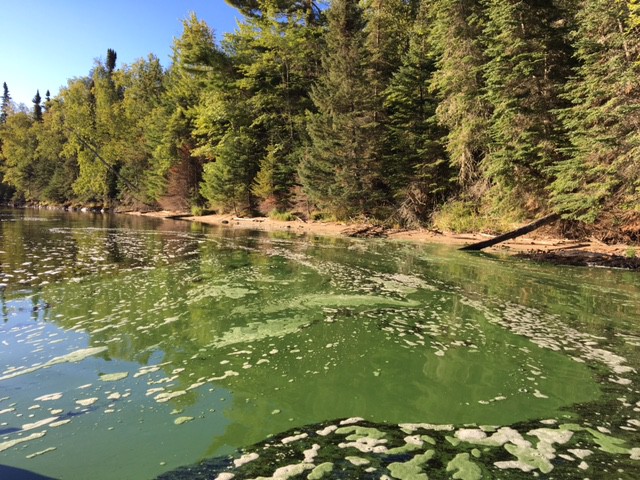
Algae that can sicken people and kill animals have recently bloomed on parts of two lakes in Voyageurs National Park. The blooms were spotted this fall on Kabetogama Lake and Black Bay of Rainy Lake.
Species of algae known as “blue-green” can produce toxins, which are often blamed for dog deaths and skin rashes. Drinking contaminated water can cause severe illness.
While blue-green algae are natural parts of many Minnesota lakes, they have become a bigger problem in recent decades because of nutrient pollution, climate change, and other human impacts. Increased levels of nutrients – from farm fields, septic systems, lawns, and industrial activity – spur more growth. Changes in wind, temperature, and other climate conditions keep the nutrients moving around.
On nearby Lake of the Woods, nutrients that were dumped into the water by paper mills before the Clean Water Act of 1972 are believed to still be circulating between the bottom sediments, the water, and the aquatic plants. Meanwhile, increased wind is more often mixing the lake waters together, and warmer temperatures are creating a longer growing season.
“The blooms in Voyageurs fit the same pattern we are studying in many lakes, where traditional external nutrient sources are not the drivers of the blooms, but rather lake behaviour,” says Mark Edlund, senior scientist with the St. Croix Watershed Research Station. “It continues to highlight the importance of monitoring even in our pristine and wilderness lakes.”
Blue-green algae are not always visible, even when their toxins are present. The Minnesota Pollution Control Agency recommends caution.
“If it looks and smells bad, don’t take a chance. We usually tell people: If in doubt, stay out,” said Pam Anderson, MPCA Water Quality Monitoring Supervisor. “If you’re not sure, it’s best for people and pets to stay out of the water.”
For questions regarding blue-green algae blooms, symptoms, and precautions, visit the MPCA website or call the MPCA at 1-800-657-3864 and ask for specialists in blue-green algae.

